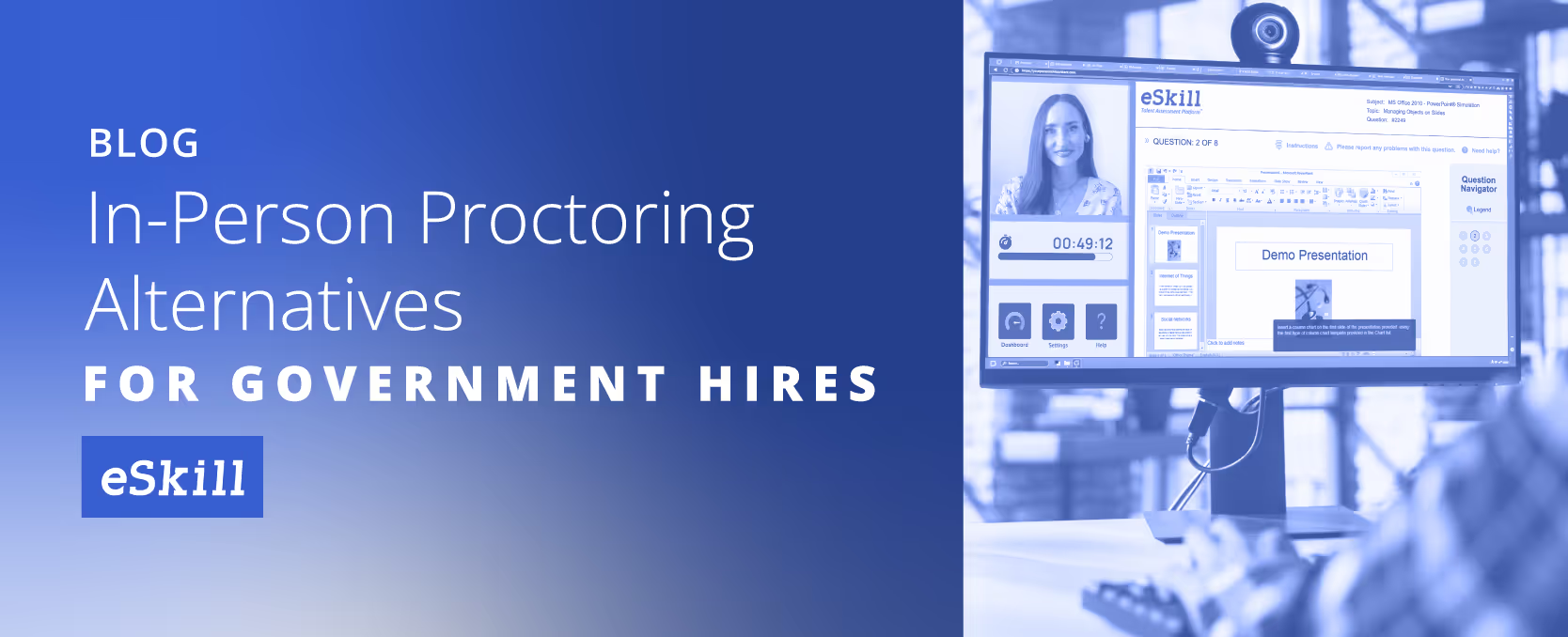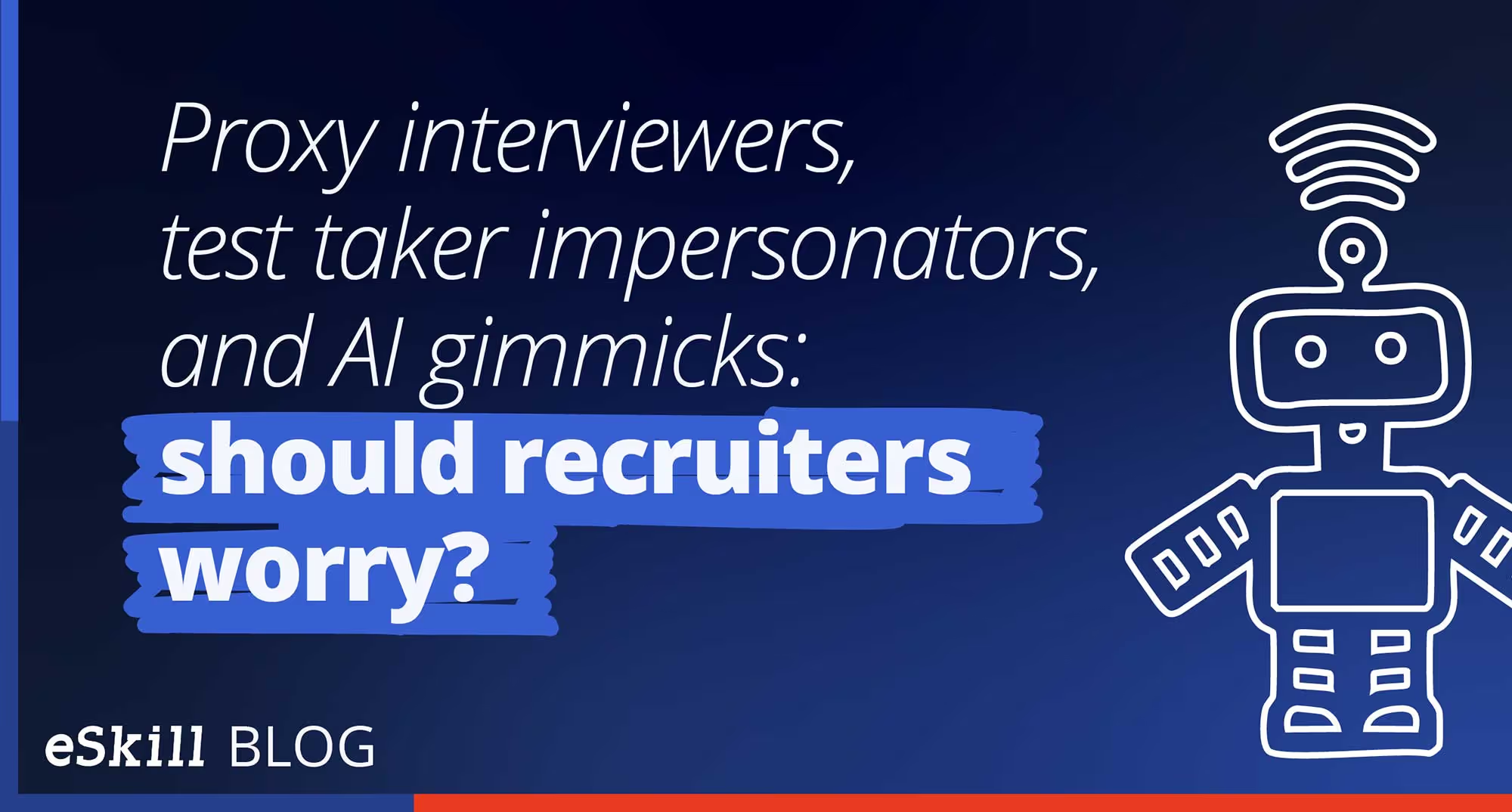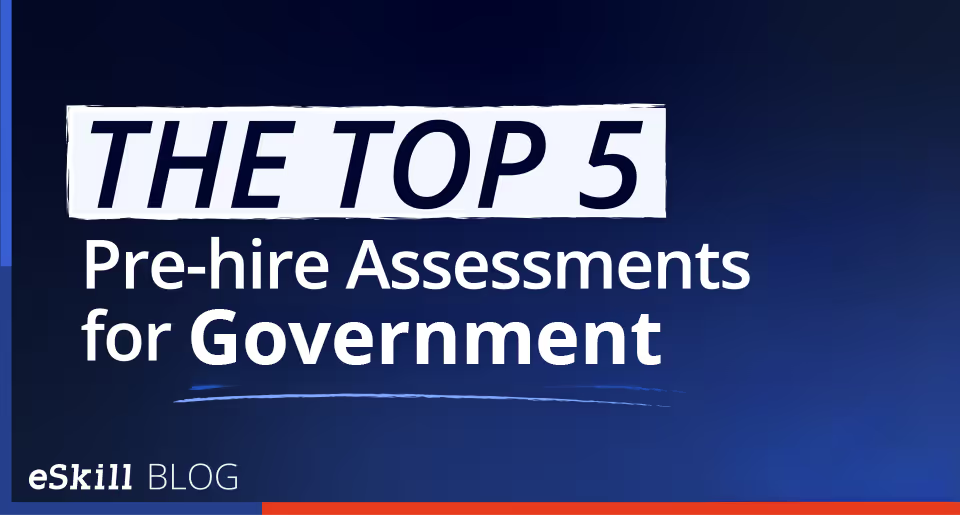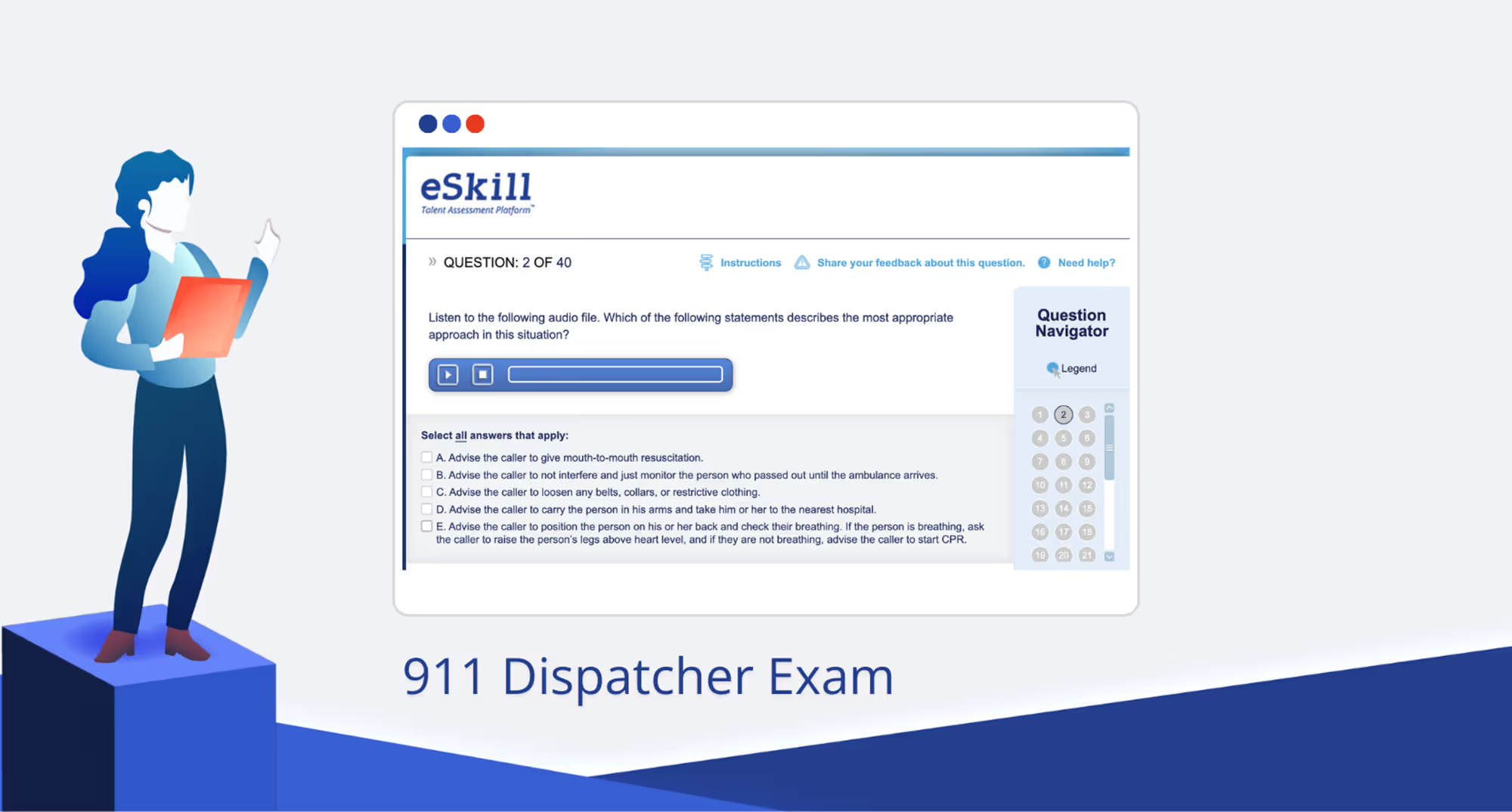Federal, state, and local agencies are increasingly moving government personnel and civil service exams online. But these roles often have to be proctored to meet hiring compliance and guidelines. How do you evolve in-person proctoring to match online testing?
What you should know:
- Government agencies at all levels are adopting virtual testing and remote proctoring for government personnel, driven by scalability and cost-efficiency.
- Despite the rise of remote exams, in-person proctoring remains essential for high-security government roles due to the need for identity verification, standardized conditions, and test integrity. Yet you can get much of the same through virtual proctoring.
- eSkill supports virtual proctoring and anti-cheat tools, helping agencies digitize legacy tests, reduce fraud, and ensure secure, flexible hiring processes.
In the City of Los Angeles, most government personnel are tested — and interviewed — virtually before they’re hired. The local government has made a significant transition away from in-person proctoring to remote testing for many positions, both as a way to “ensure equity” in the exam process and continually “promote the health and safety” of candidates following pandemic protocols. Some assessments include remote proctoring involving room scans (we know, a little controversial), or occasionally, live oversight from a Personnel Department representative.
This shift isn’t unique to LA. Many other local, state, and federal governments have also hopped on the virtual-testing train. The federal government, in particular, has leaned into generalized, unproctored online assessments, though applicant perspectives vary quite a bit on the practice — especially because the exams are standardized cognitive assessments, rather than measures of relevant skills to the jobs at hand. When assessments feel irrelevant and go unproctored, candidates may have more reason to cheat.
What’s the case for taking traditional in-person proctored exams in government — like those for firefighters and police officers — online, like the City of Los Angeles? And on the other hand, what’s the case for expanding proctoring on typically unsupervised online government tests?
To get our answer, let’s imagine we’re all male citizens in ancient China. Maybe some of us are peasants, and some of us are from wealthy merchant families. Maybe some of us are members of the gentry, or simply clerks or sons of bureaucrats (we promise this is a relevant exercise).
A brief history of in-person proctoring in government
The imperial examination system, developed during the Sui and Tang dynasties and expanded under the Song, was one of the earliest and most influential models of civil service testing. Candidates were tested on Confucian principles, classical texts, and literary ability — chosen for roles based on merit rather than birth. (So whether you’re a peasant or a wealthy son of a scholar, you had a chance to take the civil service exam. Well, in theory.) This marked one of history’s first large-scale efforts to staff government positions through competitive exams.
Centuries later, the idea of merit-based bureaucracy spread — very, very slowly. In Europe and early America, political patronage and nepotism were still the norm. In the early U.S., this took the form of the spoils system, especially under President Andrew Jackson, who rewarded political loyalists with government jobs. Unsurprisingly, this led to widespread inefficiency, corruption, and underqualified appointees.
However, once President James Garfield was assassinated by an irate office-seeker in 1881, public backlash spurred Congress to pass the Pendleton Civil Service Reform Act, which created the US Civil Service Commission and mandated that federal jobs should be awarded based on merit, not political affiliation. It also introduced competitive exams for about 10% of federal government positions.
Over time, the number of exam-based roles grew. By the 1930s, merit-based hiring had become standard for a large portion of the federal workforce. States and local governments soon adopted similar civil service systems. These tests were often taken in large rooms — on paper, obviously — with the oversight of a proctor.
In the 1960s and beyond, the Civil Rights Movement spurred efforts to make these exams more equitable. The Equal Employment Opportunity Commission (EEOC) and the courts began scrutinizing hiring tests to prevent discriminatory outcomes. Exams had to be validated — shown to be job-relevant and fair across demographic groups.
By the late 20th century, however, traditional civil service exams began to decline, owing to both lawsuits claiming the tests were discriminatory and a broad shift toward resumes, interviews, and self-assessments, though written tests remained common in fields like law enforcement, firefighting, and clerical roles.
However, by the 21st century, civil service exams began coming back in vogue.
The practice of using online hiring assessments was developed by the US Office of Personnel Management in the early 2010s under the Obama administration, reviving the tradition of merit-based civil service exams that were common from the 1880s through the mid-20th century — mostly to help with the massive amounts of applications that government positions began receiving online. Following an executive order from the 2020 Trump administration to encourage skills-based hiring, the popularity of these exams increased even more, and now, over 80 federal agencies use virtual assessments in hiring.
Yet while the federal government used to be on the bleeding edge of innovation when it came to pre-hire testing, the system hasn’t changed much in the past decade — when customization and virtual proctoring made them even more effective.
The current state of government testing and proctoring
The federal-level hiring assessments implemented are generalized, and majority unproctored. While in theory, the idea is good, the tests currently used across federal agencies could be better if they were relevant to the specific skills required by the jobs at hand, and proctored, for that matter. With many applicants questioning the effectiveness and relevance of these generalized tests, with some abandoning the assessment midway through, in addition to rumors of widespread cheating, these unproctored assessments may not be as effective as they claim to be.
And many roles with high security requirements or that involve handling sensitive data have assessments that are still done in person at testing centers, with a physical human proctor present. Many cities and states still conduct certain tests, like for fire and police personnel, in person, too.
Yet virtual proctoring, on the whole, is picking up steam. Remote proctoring rapidly increased in usage during 2020 through 2021, necessitated by stay-at-home orders, yet it continues to be used, both for convenience and expanded applicant reach.
Virtual proctoring is already common among colleges and universities — because testing for acquired knowledge is useless if cheating is rampant, and accreditation relies on ensuring students meet learning standards.
It’s also common in hiring for many non-governmental roles, especially when testing for specific knowledge or skills (medical terminology, welding, etc.). A proper body of knowledge is critical to roles like these. Proper knowledge is just as critical in governmental roles.
When to use in-person proctoring
Government roles often require high-level security clearances, particularly those related to public safety, law enforcement, or access to sensitive data. For high-security positions or defense-related agencies, testing is typically conducted in person to maintain rigorous standards around confidentiality.
In-person proctoring also helps prevent cheating or impersonation, allows verification of candidate identity through official documentation, and ensures consistent testing conditions.
But secure, in-person testing is also more expensive, limited by location, and difficult to scale. That’s why many government agencies are increasingly exploring virtual proctoring solutions as a more flexible alternative.
Why use virtual proctoring?
Proctoring matters — especially for high-risk roles.
The reason to proctor in-person assessments is clear enough. When you’re hiring for high-risk positions like firefighters and police, you want knowledgeable, trustworthy individuals in those positions. When testing for high-security federal roles, you want the same.
In the case of federal-level online tests, the reason to use virtual assessments was clear. In the face of record numbers of applicants, federal agencies needed to streamline hiring and reduce the number of resumes recruiters had to flip through. While this improves efficiency, it also introduces risk — especially with unproctored assessments. In fact, some National Park Service employees have raised concerns that generic exams based on “cognitive” ability don’t always reflect the real-world skills needed for the job (how you steer a raft down a river, for example) — and the lack of oversight can create opportunities for dishonesty.
Whether you’re hiring a firefighter, a police officer, or a federal agent, trustworthiness and competence are non-negotiable. That’s where virtual proctoring comes in: it bridges the gap between security and scalability.
Here’s a closer look at some of the benefits.
Hire for Remote Roles
Take the U.S. Department of State, for example: candidates for the Foreign Service Officer Test (FSOT) can take the exam remotely via online proctoring — allowing applicants from around the world to participate. For globally competitive government positions, virtual proctoring is often the best (and only practical) option.
With AI-powered proctoring, agencies can also offer asynchronous testing across time zones, removing scheduling bottlenecks and expanding access.
Get a Cost-Effective Solution
Virtual proctoring dramatically reduces overhead. There’s no need to rent physical testing centers or hire in-person proctors — making it far more cost-efficient, especially at scale. It also cuts travel and administrative costs for both candidates and agencies.
Scale up your Testing
Virtual proctoring removes physical limitations. For high-demand roles — like firefighters or police officers — agencies can test hundreds or even thousands of candidates simultaneously, without being constrained by room size or location.
What are the Types of Virtual Proctoring?
Virtual proctoring is undoubtedly on the rise. The global online exam proctoring market was valued at approximately $836 million in 2023 and is projected to more than double, reaching over $2 billion by 2029 — fueled by the growth of online education, the demand for secure remote assessments, and advancements in AI.
So, what exactly is virtual proctoring? As the name suggests, it's the process of monitoring an exam remotely to maintain academic or assessment integrity.
Here’s how it typically works: most remote assessments use a lockdown browser, which restricts the test taker from opening new tabs, applications, or navigating away from the test window. This is often paired with additional anti-cheating measures, such as AI-based behavior monitoring, ID verification, and room scans.
Proctoring can be done in four main ways, which we’ll cover below.
Live Proctoring
A human proctor monitors the test-taker in real time via webcam, screen sharing, and audio — closely mimicking a traditional in-person testing environment. This method is typically preferred when exam security, regulatory compliance, or test integrity is especially critical.
Recorded Proctoring
This type of proctoring involves recording the entire test session from the candidate’s webcam, so it’s available to be reviewed by proctors after the testing has ended.
Automated proctoring
An AI, software-based “proctor” monitors the test taker via webcam and microphone, flagging suspicious behavior for later viewing. During the test, AI looks for “violations” — like the test-taker looking away, other faces in the frame and abnormal keystrokes. After the exam, flagged footage is reviewed by staff before a decision is made. This type of proctoring is typically used for lower-stakes or high-volume pre-screening assessments.
Anti Cheat Tools
Anti-cheat tools include browser lockdown, restrictions on tab switching and copy-paste functions, and could even include timed questions. Platforms like eSkill implement these software features to allow for higher test integrity.
Which Government Roles Can Use Virtual Proctoring?
Virtual proctoring is a flexible, scalable solution that can be applied across a wide range of local, state, and federal hiring scenarios. Here are just a few areas where it makes a big impact:
Law Enforcement & Fire Services
Historically, exams for police and firefighter candidates were conducted in person. But as these processes move online, virtual proctoring ensures test integrity at scale, allowing agencies to assess hundreds or thousands of candidates without compromising security.
Skilled Trades & Technical Roles
From welders and electricians to mechanics, customer service specialists, and field technicians, many of these professionals serve in government roles.
Virtual proctoring makes it easy to administer practical, skills-based assessments before onboarding, just as is done in the private sector.
Clerical & Administrative Roles
Need to validate typing speed, Excel proficiency, or familiarity with specific government software?
With virtual proctoring, agencies can deliver simulations and digital skills tests for roles like administrative assistants, accounting clerks, and data entry staff — ensuring candidates are ready to hit the ground running.
Why use eSkill for Government Pre-Hire Tests?
eSkill allows for both remote proctoring and automated proctoring — and it’s backed by robust anti-cheat software. eSkill’s proctoring process is designed to seamlessly safeguard the integrity of your assessments, combining advanced technology and human oversight to ensure secure, reliable, and fair results every time.
That — and we also let you customize assessments. That means you can test for position-based knowledge (do you know how to fell a tree?).
Digitize Paper-Based Exams
Still using paper tests? We can help you become more efficient. eSkill makes it easy to convert your in-person exams into fully digital assessments — not just with proctoring, but across your entire testing process.
Authenticate Candidates
Verify candidate identity with photo ID checks before before the hiring test begins. This confirms that the individual taking the test is the intended participant.
Automated Monitoring Tools
Our built-in AI monitors candidate behavior throughout the assessment. eSkill detects red flags like copy/paste attempts, tab switching, and abnormal activity, helping you identify and address potential cheating in real time or during post-test review.
Video Proctoring
Need more rigorous oversight? Opt for remote proctoring to monitor a test-taker in real time via webcam. It’s the digital equivalent of a proctored testing room — ideal for high-stakes roles.
Integrate with NeoGov
We offer direct integration with NeoGov — the leading HR platform built specifically for public sector hiring. Whether your agency has 100 or 60,000 employees, eSkill works with NeoGov to simplify testing workflows and streamline candidate evaluation.
Customized Assessments
Unlike our friends from the Parks and Wildlife Department still using generic tests for hires, you can ditch the generalized, one-size-fits all approach and use customized assessments that actually measure skills needed for each job.
Get Ongoing Support
Our support staff is always here to help. If you need help digitizing paper tests, creating custom questions, or navigating the eSkill platform, you can get in touch with us for assistance.
Learn first-hand why so many local, state, federal, and international agencies like the City of Philadelphia, the State of Colorado, and the World Health Organization have partnered with eSkill, both for remote testing and for virtual proctoring. Get in touch with us for a demo.
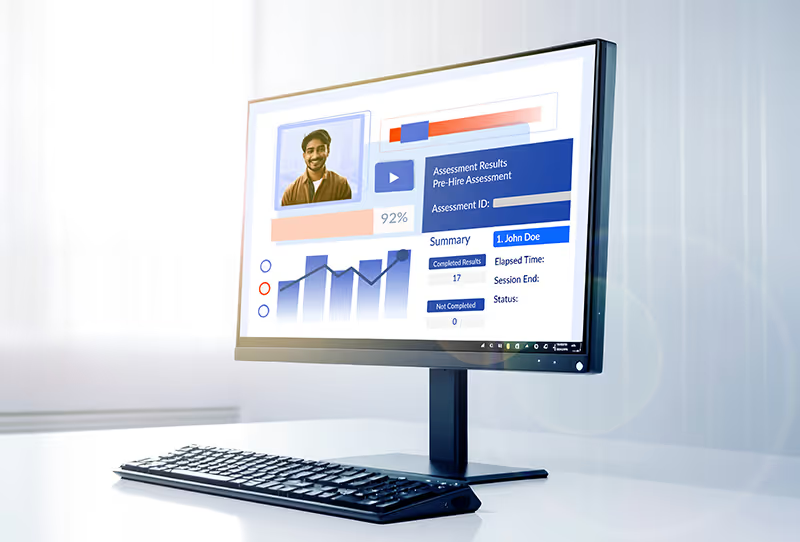
Get ademo.



